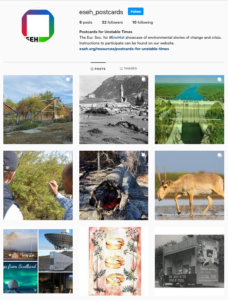 The European Society for Environmental History invites contributions to the online project “Postcards for Unstable Times.” In this project the Society explores alternative ways to showcase stories, environments, and landscapes from throughout Europe (and potentially beyond). We have focussed our attention on (digital) postcards as medium and you can visit our exhibition at @eseh_postcards on Instagram.
The European Society for Environmental History invites contributions to the online project “Postcards for Unstable Times.” In this project the Society explores alternative ways to showcase stories, environments, and landscapes from throughout Europe (and potentially beyond). We have focussed our attention on (digital) postcards as medium and you can visit our exhibition at @eseh_postcards on Instagram.
The postcards are intended to be windows of opportunity that may provide alternative readings of the world in times of crisis and radical change. The authors use their skills as environmental historians and humanists to speak to the future from the present, the present from the past, or the past from the future. Our hope is to present stories that may contribute to a sense of the incommensurable scale of the changes we are facing. To use Arundhati Roy’s metaphor, we aim at offering portals into another world.[1] And, to cite Andri Snær Magnason, we explore what words we can use to effectively describe such a world.[2]
We now invite submissions to be published before the upcoming ESEH conference in Bristol, 4–8 July 2022. Contributors may submit at any time before 15 June 2022. Successful submissions will be queued up to be published before the conference. Questions may be directed to the project’s manager Jonatan Palmblad at postcards@eseh.org.
Guidelines
- First you will need to choose your ‘postcard’ image (or images, if you want to make a collage). This won’t be an actual historical postcard, but it will need to fit the traditional format of postcards: 10×15 cm or 4”x6”.
- Please ensure that the images you use are out of copyright, have a creative commons license, or you are the copyright holder. The back will be made public under a CC-BY license.
- Write approximately 300 words in the form of a letter to the future from the present, from the past to the future, or from the future to the present or past, relating to the image on the front of the postcard (using your skills and insights as an environmental historian). This text will go into the comment field on Instagram. Feel free to include suggestions for hashtags and your Instagram handle (if you want and have one) in your letter.
- Imagine to whom you want to address your postcard. What actually goes in the address field is up to you and should depend on your message. The idea behind it is to maintain the postcard similitude, while giving you the possibility to specify for whom your message is. For example, if the postcard were about a disaster caused by a dam, you could decide to address it to the affected communities, to the association of people fighting against big dams in Brazil, etc.
- Print out the attached template, and handwrite both the address and a slogan, teaser, or summary of your 300-word letter. This should be no more than 50 words. Then scan this (or take a good photo of it with your phone) and return it along with the image and a text file with your 300-word letter.
- Fill in the description of the photo and the credits at the bottom of the attached template.
- Another possibility is to produce an actual postcard and send it to us by mail: drop us an email at postcards@eseh.org to get further details for this option and a postal address.
We look forward to your submission!
[1] Arundhati Roy, “The Pandemic Is a Portal,” Financial Times, 3 April 2020, https://www.ft.com/content/10d8f5e8-74eb-11ea-95fe-fcd274e920ca
[2] Emmanuel Vaughan-Lee, “On Time and Water – a Conversation with Andri Snær Magnason,” Emergence Magazine, https://emergencemagazine.org/story/on-time-and-water/